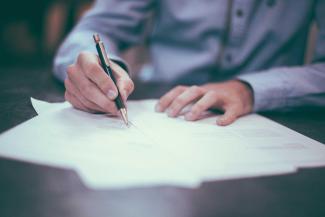
By Benjamin Thornton on Sep 11, 2017
I snore.
Loudly.
I was once sleeping at an outdoor event and people were convinced they were being attacked by werewolves until they realized the sound was coming from me. (Granted we were role playing, so werewolves were an actual possibility).
I had tried snore strips (one of the few products where I truly believe the brand name is better than the store brand),snore sprays, and prescription nasal sprays, but nothing would help. More telling, my wife noticed that I seemed to stop breathing while I was asleep.
However, I didn’t do anything about it until after a cross-country flight. During the flight, I fell asleep only to wake up gasping for breath and feeling like I was choking. I don’t know how long I wasn’t breathing, but it was one of the scariest moments of my life.
I spoke to my doctor, and he agreed I should see a sleep specialist to be tested for sleep apnea. After an initial consult, I was set up for two overnight appointments. The first to see how my apnea was and the second to determine what pressure of CPAP I would need if I did indeed have apnea.
A sleep study is an interesting experience. You fill out a survey about your normal sleep habits, put on your pajamas, then a technician covers your face with electrodes to identify the stages of sleep, leads on your body to monitor your heart and a oximeter on your finger to measure your blood oxygen level. None of these devices are wireless. You’re lead to a bed that is being monitored by a video camera (so they can see what position you’re sleeping in) and plugged in.
They try to get 8-9 hours of data, so most sleep studies are from 9-6 or 10-7. For people with sleep apnea this isn’t nearly as bad as it sounds to night owls because we’re always tired. Being told that we can go to sleep can be a relief. I think I was out in about five minutes. When you wake up, they give you another survey about how well you felt you slept, then send you home. While the technician doesn’t have a full report of the study findings, he was able to tell me immediately that I was going to need to come back for the second part of the study.
The second part is called a CPAP titration. The setup is the same except they also put a mask on you so they can increase the air pressure so you can actually get oxygen in your lungs. They adjust the pressure until they find the level where your body can breathe normally. Eventually, they found that I needed two different pressures. One for inhaling and one for exhaling. After that study, I woke up the most refreshed I had in years. I was finally getting oxygen while I slept.
And that is the real problem for people with sleep apnea. The snoring is annoying, but it can be dealt with. However, if you’re not breathing, you end up with low oxygen levels. My study came back with an AHI of 51. That means on average, I stopped breathing (or breathed only shallowly) 51 times each hour. My blood oxygen level dropped to 79%.
Let’s put that into perspective. A blood oxygen level of 95-97% is considered normal. At 92% your cells begin to lose the oxygen they need to survive. Less than 90% you are diagnosed with hypoxemia which can lead to brain and liver damage and heart attacks. My level got down 11% lower than that.
As I learned more, I realized I must have had sleep apnea for years. In high school, I would constantly fall asleep in my classes. One teacher had the solution of turning down the temperature to keep me awake. It didn’t work, and I apologize to everyone in my math class for the freezing temperatures.
My case of sleep apnea is severe, but it is difficult to determine how severe unless you have a sleep study. I urge anyone who thinks they, or someone they know has apnea to talk to their doctor and schedule a study. If you do have apnea, please follow your treatment. There are many different masks on the market now, and if you don’t like the one you have, ask your supplier for a different model until you find the right one for you. It’s not to stop your snoring (although your spouse will approve of that side effect). It’s to protect your heart, your liver, and your brain.
